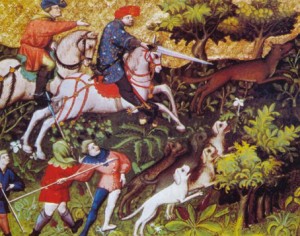Wolf Hunting with Dogs – A History of Hounds
258 – May, 2016
Text and illustrations by Ria Hörter courtesy of Ton Popelier
 Through the ages, wolves have captured mankind’s imagination. They have played a role in old civilizations, art and literature, myths and fairy tales. Wolves were threatening Neolithic settlements 14,000 years ago, but the official and concerted hunt on wolves didn’t begin until the Middle Ages, when the wolf population was deemed too large and threatening, and wolves were demonized.
Through the ages, wolves have captured mankind’s imagination. They have played a role in old civilizations, art and literature, myths and fairy tales. Wolves were threatening Neolithic settlements 14,000 years ago, but the official and concerted hunt on wolves didn’t begin until the Middle Ages, when the wolf population was deemed too large and threatening, and wolves were demonized.
Dogs to Assist the Hunters
Wolves were hunted to protect people and their livestock, but also for their pelt, and the sport of it.
The opinion about wolf hunting has changed through the ages. Opponents believe it is a needless and cruel pastime; supporters are convinced that wolves must be kept under control, or they would be a great danger to remote villages. By the end of the 20th century, wild animals from Russia, Romania, Poland and the former USSR were enlarging their territories and heading west. Among them were wolves. In 2015, my homeland, The Netherlands, was in an uproar. For the first time in 170 years, a wolf was being reported in the fields and even on the streets in some villages.
The way wolves were hunted differed through the ages, but in the end, dogs were used everywhere to assist the hunters. Russian Borzoi, Irish Wolfhounds, Norwegian Elkhounds, Transylvanian Hounds in Hungary, Chart Polskis from Poland and the French Poitevins were, among many others, excellent wolf hunters.

Wolf Hunters
In the early Middle Ages, wolves were regarded as malicious animals full of dark powers, killers of livestock and humans. The truth is that wild wolves generally fear people and rarely pose a threat to human safety.
In the early days, every available means was used to kill wolves. This was not entirely without reason. Old documents show that in severe winters, wolves were known to attack and kill livestock and humans, especially children.
In 813, the emperor Charlemagne (ca. 742-814), who united most of western Europe during the early Middle Ages, appointed two wolf hunters in each district of his empire. They were to inform him on a regular basis how many wolves they had killed.
By 1100, there were many officially appointed wolf hunters in Europe and England. It was decided at the Synod of Santiago that on every Saturday (except the Saturdays before Easter and Pentecost), every man must participate in a wolf hunt. The fine for not showing up was five cents for a priest or a nobleman, the same sum or a sheep for a farmer.
Click here to read the complete article258 – May, 2016
Short URL: https://caninechronicle.com/?p=103604
Comments are closed











